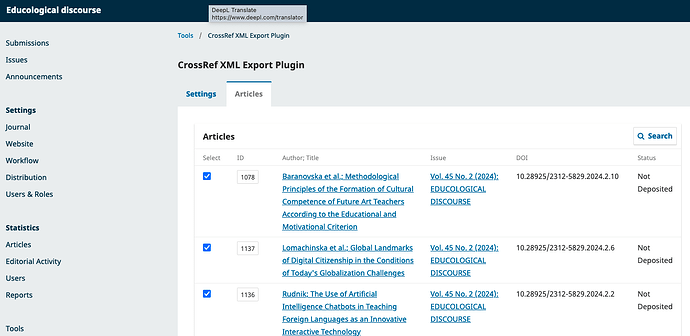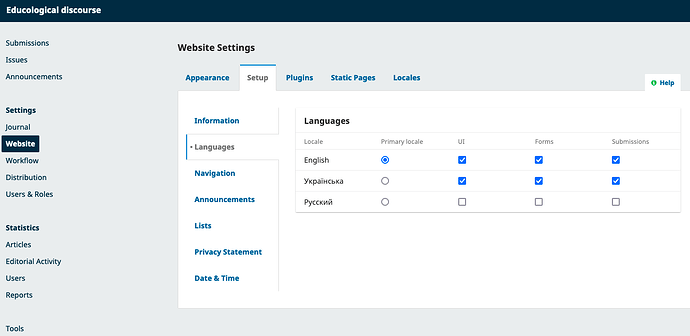Hi @Serhii_Nazarovets ,
Are the full text versions of your journal articles in question available in both English and Ukrainian?
I don’t see that they are for the examples I am finding on your site, but because this is a public forum and I want to be thorough; so, I am going to address that question first - what to do about an article published online (in full text) that is available in two languages.
If, in your example, the journal articles are published and available in English and Ukrainian, best practice would be to register a DOI for both the English and Ukrainian articles, since the article in English would be cited differently from the article in Ukrainian (and, journal article DOIs are really citation identifiers). In this hypothetical example, the article in English would be register as the primary DOI with only the journal title in English appearing in the XML registered with Crossref, like this:
<titles>
<title>Computer-based Testing: A Necessary Evil or a Sensible Choice?</title>
</titles>
Then, the Ukrainian translation of that journal article in English would be registered with its own distinct DOI and then linked to the DOI of the journal article in English. The title metadata would be registered with us like this (note: I have translated the title using Google Translate, so I don’t know how accurate it is):
<titles> <title>Комп’ютерне тестування: необхідне зло чи розумний вибір?</title><original_language_title language="en">Computer-based Testing: A Necessary Evil or a Sensible Choice?</original_language_title> </titles>
You’d also want to include a relationship in the metadata of the Ukrainian translation to link back to the journal article in English, like this:
<program xmlns="https://www.crossref.org/relations.xsd">
<related_item>
<description>Ukrainian translation of an article</description>
<intra_work_relation relationship-type="isTranslationOf" identifier-type="doi">10.28925/2518-7635.2020.5.10</intra_work_relation>
</related_item>
</program>
A full example of the XML needed for a translated article is available on our website. Also, relationships can be set for previously registered DOIs using what we call a resource-only deposit. An example of that for a translated article is available for review here.
Now, on to what I believe is your example: I see this DOI as an example DOI registered with us:
https://doi.org/10.28925/2518-7635.2020.5.10 .
This journal article is only available in English. There is no full-text translation of the journal article in Ukrainian, but you want to add the Ukrainian title to the metadata so it is searchable (right?). Well, you would do that by simply adding the Ukrainian title to the metadata, like this:
<titles>
<title>Computer-based Testing: A Necessary Evil or a Sensible Choice?</title>
</titles>
<titles>
<title>Комп’ютерне тестування: необхідне зло чи розумний вибір?</title>
</titles>
We would assume that the first title in the XML would be the primary title, albeit there is no primary title element in our schema. So, if you’re not following best practice as I outlined above, this is the your best option (and, based on my experience, what OJS 3.3 is doing when you include more than one title in the record).
Furthermore, and, again to focus on your example, the DOI you provided in your message - 10.28925/2518-7635.2020.5.10 - is registered with us with only English metadata, as you can see here: https://doi.crossref.org/search/doi?pid=support@crossref.org&format=unixsd&doi=10.28925/2518-7635.2020.5.10
I’ve extracted some of the article’s bibliographic metadata and am including it below so you can see that it is all registered with Crossref in English (only):
<journal_article>
<titles>
<title>COMPUTER-BASED TESTING: A NECESSARY EVIL OR A SENSIBLE CHOICE?</title>
</titles>
<contributors>
<person_name sequence="first" contributor_role="author">
<given_name>Wojciech</given_name>
<surname>Malec</surname>
<affiliation>John Paul II Catholic University of Lublin Aleje Racławickie</affiliation>
<ORCID>https://orcid.org/0000-0002-6944-8044</ORCID>
</person_name>
</contributors>
<jats:abstract xmlns:jats="http://www.ncbi.nlm.nih.gov/JATS1">
<jats:p>For many students and teachers working in online environments during the current pandemic crisis, the use of computers for educational testing is often an unavoidable predicament. This may be due to the fact that computer- based materials are not merely a useful addition to the learning and teaching resources, but rather the only option available. However, although in some contexts computers may indeed be a significant hindrance to test developers and test takers alike, they actually offer a number of substantial benefits. It is also worth pointing out that, by and large, educational tests delivered through online platforms with the aim of measuring progress and achievement in learning have a lot in common with traditional paper-based tests. This article is thus an attempt at balancing the advantages and disadvantages of computerized testing with a view to finding out whether this mode of testing can be recommended as the preferred choice. Based mainly on a literature review of research and practice in the area of computerized and online educational testing, the paper provides a synthesis of key issues relevant to using electronic devices for the purpose of constructing, administering, and analyzing tests and assessments. In particular, the discussion focuses on the models of test administration, the merits and demerits of computer-assisted testing, the comparability of paper-based and computer-based test scores, as well as selected features of web-based testing systems, such as text-to-items converters, test generators, full-screen delivery mode, automated scoring (and human verification thereof), score reporting, feedback, as well as quantitative analysis of test scores. The article also puts forward some arguments in favour of developing one’s own testing application.</jats:p>
</jats:abstract>
Warm regards,
Isaac

